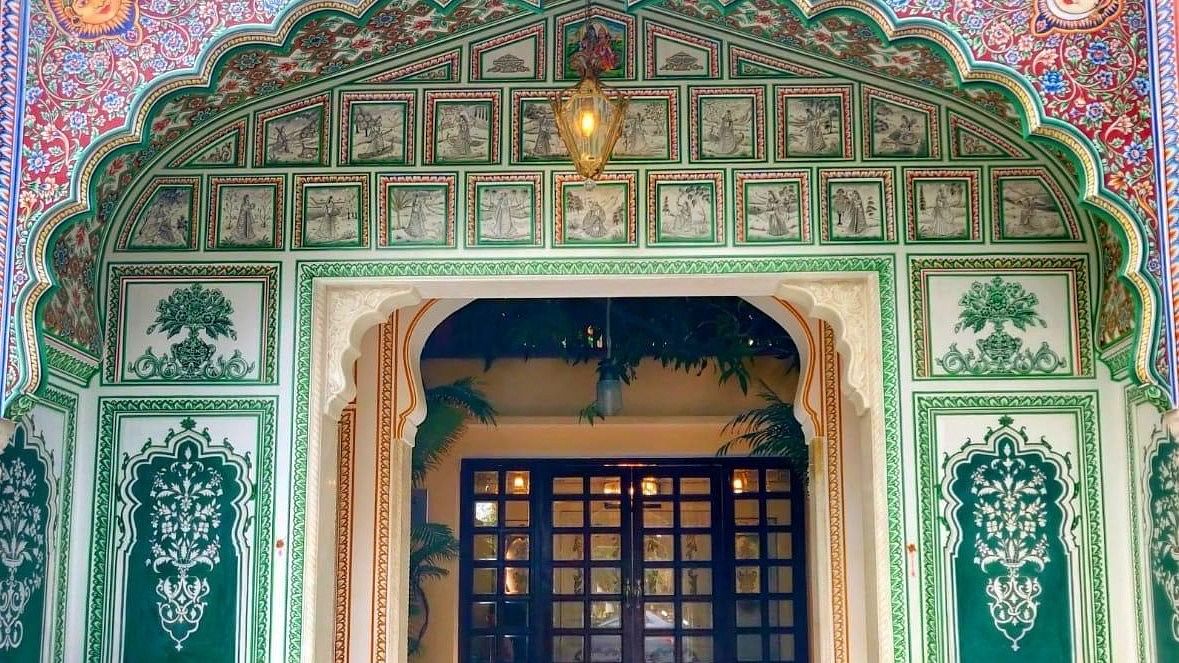
The gate of Shahpura House.
Credit: Wikimedia Commons
Bedecked Rajput princesses, English royalty, and the Hindu deity Krishna soaring through the sky in a winged motorcar: these are amongst the fantastical motifs that appear on the painted walls of the Havelis, or palaces in Shekhawati, a region in northeastern Rajasthan. These images are more than mere ornamentation. They are emblematic of the hybrid visual idioms through which migrant Marwari merchants, who commissioned them, crafted a new identity for themselves at the turn of the 19th century.
The Shekhawati region witnessed a surge in haveli construction between 1860–1900. During this period, the Marwari community grew as a powerful economic force in colonial India. Having migrated to major cities such as Bombay and Calcutta, they had begun to amass wealth through their work as traders, agents and moneylenders. They emerged as a new capitalist class in colonial India and used their newfound wealth to build elaborately painted mansions in their hometowns. The havelis they built became a canvas upon which they could express their aspirations and anxieties, their reverence for tradition, and their embrace of the modern world.
As grand statements of their success, the havelis incorporated architectural elements reminiscent of the Rajput rulers, the region’s established elite. The ornately carved cusped arches, fluted columns, and central courtyards echoed the grandeur of Rajput forts and palaces. This architectural homage signalled the Marwaris’ claim to belonging within the social hierarchy and paid respect to the region’s cultural heritage, and its established authorities.
These havelis had elaborately painted inner and outer walls, populated by modern and traditional imagery. Motifs and scenes drawn from Mughal miniature paintings intertwine with Hindu religious icons, alongside European paintings and photographs. The advent of the railway and the proliferation of printed materials, especially coloured lithographs, further broadened the visual vocabulary depicted on haveli walls. Images of industrially produced objects and indicators of modernity in the 19th century — including trains, motorcars, gramophones, sewing machines and bicycles — began to appear beside depictions of gods and mythological scenes.
These painted homes represented a twofold quest for legitimacy by the mercantile class that built them. They helped establish a legitimate ancestral homeland in Shekhawati by using the idiom of Rajput architecture favoured by the local aristocracy. They also helped the merchants fashion an image of themselves as worldly men of commerce by referencing objects emblematic of ‘modernity’.
According to scholar Anne Hardgrove, through the syncretic depiction of foreign rulers, “modern” industrial objects and Hindu deities, the Marwari merchants established their Shekhawati lineage. The traders aspired to become significant players within colonial networks of trade, commerce and power, and their havelis signal a cosmopolitan outlook befitting such aspirations.
The havelis of Shekhawati stand as more than just architectural marvels; they are a space where tradition and modernity, the sacred and the secular, coexist and converse, creating a unique visual language that speaks volumes about the cultural and social transformations of the Marwari community.
Discover Indian Art is a monthly column that delves into fascinating stories on art from across the sub-continent, curated by the editors of the MAP Academy. Find them on Instagram as @map_academy